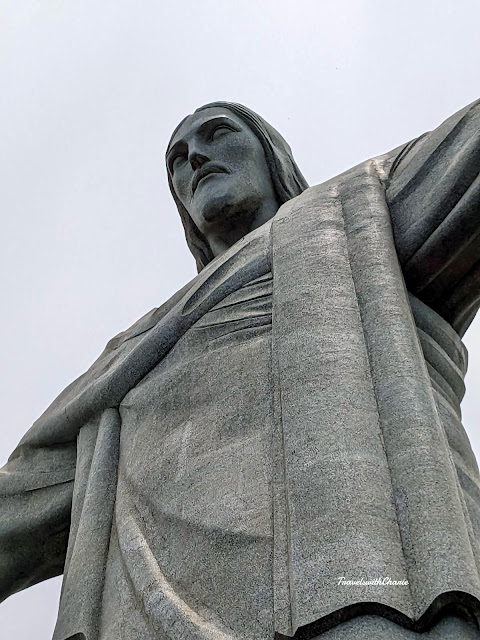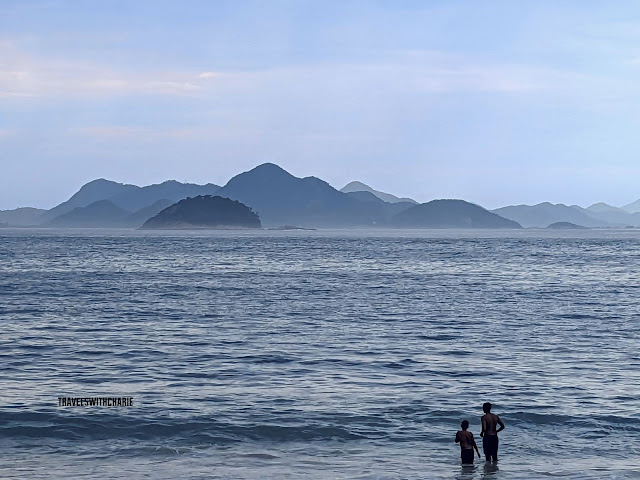 |
Cristo Redentor (Christ the Redeemer) I must confess that I went to Brazil with a lot of trepidation. After years of hearing horror stories from tourists who were robbed in Rio, I didn’t believe I could be safe there especially since I travel solo. But I decided to give Brazil a chance after reading and watching videos about the country and figured there must be a way to travel safely. I’m so glad I did because the monument of Christ the Redeemer has been on my bucket list for decades and I finally got to see it. Here are some details about the statue of Christ the Redeemer. The statue which is cast from reinforced concrete and soapstone took nine years to complete. It was designed by Brazilian engineer, Heitor da Silva Costa in collaboration with Albert Caquot, an artist. The French sculptor, Paul Landowski, created the art deco statue which stands at 98 feet above a pedestal of 26 feet. The Romanian sculptor, Georghe Leonida, was tasked to create the head of Christ. The monument was opened to the public in October 1931. |
It’s best to go with an organized city tour when it’s your first visit in any city. You don’t have to run around in circles. Instead, you can relax and enjoy the ride. This is especially true when going up to Corcovado Mountain to see the iconic symbol of Rio de Janeiro and Brazil and one of the new seven wonders of the world.
There are several options to choose from to see Christ the Redeemer: you can hike up the mountain trail, take the train, take the van/car or go on a guided tour. The train drops you off at the visitors area where you queue up for elevators that will whisk you to the terrace where you then take the escalators to the base of the statue. It may sound complicated especially for older visitors who might have mobility issues. So it’s probably best to leave the details with the tour guide. I might add that the staff at Corcovado move the huge crowds along in an orderly manner. In the photo above, you’ll see people queuing for the elevators in the background.
This link has a lot of relevant information about going to Corcovado Mountain: https://freewalkertours.com/how-to-get-to-christ-the-redeemer/. I went with Get your Guide on a half day tour which included the Metropolitan Cathedral, Maracaña Stadium and Selaron Staircase.
Sugarloaf Mountain and Guanabara Bay
One of the best panoramic views of Rio is from the top of Corcovado Mountain.
Royal Portuguese Reading Room
The Reading Room is located on the other side of town from Copacabana in the city center. I took Uber to get there. Fewer tourists visit this library which means I could explore at leisure. Time Magazine and other lifestyle publications have cited the Reading Room as one of the most beautiful libraries in the world.
There are over 350,000 volumes of Portuguese literature in the library including a first edition of the epic poem, Os Lusiadas, from 1572, by the foremost Portuguese poet, Luis de Camões.
The Reading Room is built in the Neo Manueline style. Four statues of famous Portuguese personalities stand guard at the entrance - Prince Henry the Navigator, Luis de Camões, Pedro Alvarez Cabral who discovered Brazil and the celebrated explorer of the Age of Discovery, Vasco de Gama.
Luis de Camões
The address of the Reading Room is Rua Luis de Camões, 30. Link to a short video of the library: https://youtu.be/VkIwi_zTt1s?feature=shared
Metropolitan Cathedral of St. Sebastian
The Metropolitan Cathedral of Rio de Janeiro is a stunning temple of worship. The surprising architectural style of the Cathedral is the design of Edgar de Oliveira da Fonseca after the Mayan pyramidal structures that flourished in Central America. Once inside, you are struck by four colorful rectilinear stained glass windows that radiate from the cross of clear glass at the top of the conical ceiling.
Metropolitan Cathedral
These beautiful rectilinear stained glass windows rise 210 ft. and represent the foundations of the Catholic Church - One, Holy, Catholic and Apostolic.
Metropolitan Cathedral
The Cathedral can hold up to 20,000 people. It is located in the city center of Rio.
Copacabana Beach
The first thing I did after checking into my hotel was to take a walk along Copacabana beach. It’s just so beautiful with the silhouette of the islands in the distance. The beach is a lively hang out for locals and travelers alike. There are volleyball courts, sand castles, sidewalk vendors of paintings, beach apparel, jewelry, ice cream, caipirinha and beachside restaurants where live bands play the music of the legendary, Antonio Carlos Jobim. His music is hypnotizing and my body sways to the rhythm of the beat whenever I hear his songs. It makes me feel I’m that girl from Ipanema. ;) Listen to his music here: https://youtu.be/Yytn0hWP_zE?feature=shared.
The beach is packed with sun seekers on Saturdays and Sundays. The best part is that the Avenida Atlantica by the beachside is closed to traffic on Sundays so people can cruise down the avenue on their skates or bicycles and both joggers and walkers can run or stroll along the length of Copacabana in peace. Police are everywhere so you need not worry about the dreaded muggings or pickpockets.
Avenida Atlantico along Copacabana Beach is for pedestrians, bicyclists and skaters only on Sundays.
There are several sculptures on the sidewalk along Copacabana Beach worth noting. The seated figure is Carlos Drummond de Andrade, a Brazilian poet. In the background is Copacabana Fort. Note the pattern of the sidewalk. Ipanema Beach sports a different pattern from Copacabana Beach.
Arpoador Beach (between Copacabana and Ipanema)
On Sunday, I decided to walk along the beach from Copacabana to Ipanema which took me about 40 minutes as I stopped to check out all the curiosities I found along the way.
How I stayed safe in Rio as a solo traveler
I loved Rio! The people were friendly and they didn’t have a care in the world about body appearances as they donned skimpy swimsuits and frolicked on the beach. I walked a lot by myself during my stay and was never bothered or threatened by anyone. Of course I avoided going out at night and went around “safe” areas. How do I know the area is safe? It’s not isolated. Second, it’s far enough from the “favela” neighborhoods. A few other precautions I took were to select a hotel within walking distance from the beach. It is also surrounded by other hotels and businesses therefore there is a flow of people all day long. Secondly, I dressed simply and wore no expensive jewelry. Third, I used an ordinary canvas bag to keep a minimum of things I needed including my phone, alcohol wipes, a small amount of currency to spend for meals and sunglasses. When I wasn’t using my phone camera, I stored it inside my bag. Fourth, I kept my money and cards in a travel pouch under my dress or shirt. If there’s a will, there’s a way to travel to the places people have warned you to stay away from. But it’s important to keep your guard at all times.
Visa Requirement for U.S., Canadian and Australian nationals:
The government of Brazil will reinstate the visa requirement on January 10, 2024. Check here for details. https://brazil.vfsevisa.com/
How to get to Copacabana from the airport:
I took an Uber from the airport to my hotel in Copacabana. It costs R$85.82 or USD17.38. It took around 25 minutes from Tom Jobim Intl. Airport to Copacabana. It’s cheaper to take Uber to Santos Dumont Intl. Airport as it is closer to Copacabana.
Where to stay:
Ibis Copacabana Posto 5
Rua Javier da Silveira, 82
The hotel is three blocks from the beach and is surrounded by restaurants, two supermarkets and shops. www.accor.com
Where to eat:
Sushi Yapa, Rue Bolivar
The second largest number of Japanese residents outside of Japan are in Brazil so it’s not surprising to find many Japanese restaurants. Yapa had the best Japanese food of the three restaurants I tried in Rio. They also serve a generous amount of food.
Bar Oligario, Rue Bolivar
This is a busy restaurant/bar with a view of Copacabana Beach. Fast and efficient service and a varied menu.
Currency:
One USD is equal to 4.97 Brazilian Real as of November 2023. I had tried a couple of ATM machines from different banks but these didn’t accept my cards. The attendant at one of them pointed me to the Banco 24 Horas which is inside the Carrefour Express supermarket. There was also one in my hotel in Rio. I found Banco 24 to be my best option as it is in many locations throughout Sao Paolo and Rio de Janeiro. Banco 24 is an interbank network that includes Itaú Unibanco, Santander, Bradesco and Banco do Brasil.
Electrical adaptor:
Brazil uses two plug types, C and N. C has two round pins and N has two round pins and a grounding pin. They operate on a 127/220V supply voltage and 60Hz.



















